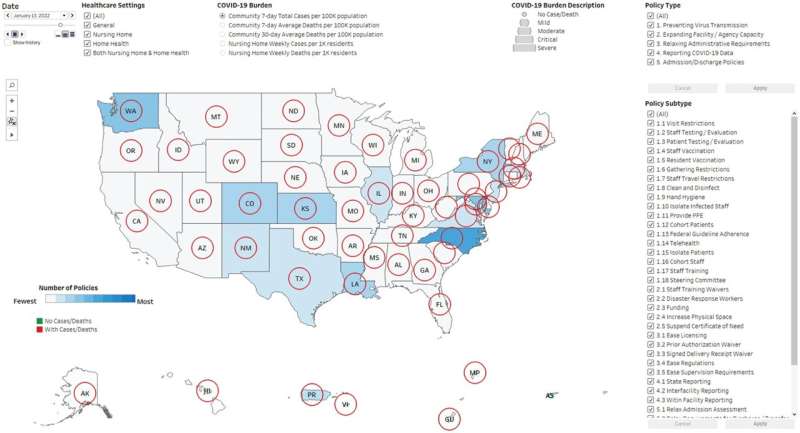This article has been reviewed according to Science X's editorial process and policies. Editors have highlighted the following attributes while ensuring the content's credibility:
fact-checked
peer-reviewed publication
proofread
Study gauges effectiveness of COVID-19 burden mitigation policies

In a new study published in JAMA Network Open, researchers have created a dataset and data visualization dashboard to evaluate the effectiveness of state and territory-level policies enacted to reduce the severity of COVID-19's impact on older people served by home health care agencies and nursing homes.
The authors found many policies within states and territories did not correspond with reductions in community or nursing home-level COVID-19 burden (i.e. number of cases and mortality counts). This suggests that policy effectiveness may depend on implementation and compliance. The study also found that policies focused less on home health care agencies compared with nursing homes, despite both settings serving vulnerable older populations.
"This suggests a gap in public health planning, raising questions about resource allocation and prioritization among health care settings during the pandemic," the paper says.
The research team, led by Patricia Stone, Ph.D., Centennial Professor of Health Policy at Columbia Nursing, conducted this study by first combining data on COVID-19 policies from the Council of State Governments with COVID-19 burden data from the Center for Medicare & Medicaid Services. The team then used data visualization software to depict the information. They were able to identify 1,400 policies across 50 states and five territories.
"Both tools can be used by policymakers and medical professionals to learn from the past and prepare for the future as we anticipate more public health crises. We also suggest that these types of tools are made available during crises to ensure decision-making is data-driven," says Stone.
Other study authors include Suning Zhao, MPH, Ashley M. Chastain, DrPH, Uduwanage G. Perera, Ph.D., and Jingjing Shang, Ph.D., all of Columbia Nursing's Center of Health Policy; Laurent Glance, MD, Department of Anesthesiology and Perioperative and Department of Public Health Sciences, University of Rochester School of Medicine; and Andrew W. Dick, Ph.D., RAND Health, RAND Corporation.
More information: Patricia W. Stone et al, State- and Territory-Level Nursing Home and Home Health Care COVID-19 Policies and Disease Burden, JAMA Network Open (2024). DOI: 10.1001/jamanetworkopen.2024.7683















